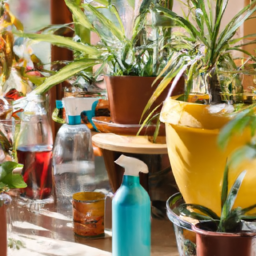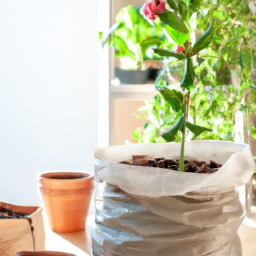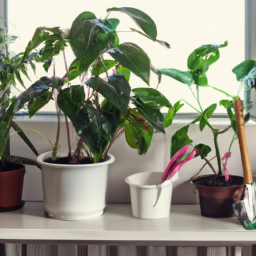
Have you ever wondered, “Can I plant indoor plants outside?” Many people are unsure whether their beloved houseplants can thrive in an outdoor environment. In this blog post, we will explore the possibilities of moving your indoor plants outdoors and provide tips on how to successfully transition them to a new environment. Whether you are looking to give your plants a breath of fresh air or simply want to experiment with new growing conditions, this post will help you make informed decisions about your indoor plants’ outdoor potential.
Benefits of Transferring Indoor Plants Outside
Introduction
When it comes to indoor plants, many people may wonder if it is possible to transfer them outside. The good news is that in most cases, it is indeed possible to plant indoor plants outside. This can have several benefits for both the plants and the plant owner. In this article, we will explore the benefits of transferring indoor plants outside and provide a step-by-step guide on how to do so successfully.
Benefits of Transferring Indoor Plants Outside
One of the main benefits of transferring indoor plants outside is that they can receive more natural light. Indoor plants are often limited in the amount of sunlight they can receive, especially if they are placed in a room with limited windows or if the windows are shaded. By moving indoor plants outside, they can benefit from the full spectrum of natural light, which can help them grow stronger and healthier.
Another benefit of planting indoor plants outside is that they can benefit from the fresh air. Indoor air can often be stagnant and filled with pollutants, which can hinder the growth of plants. By moving plants outside, they can benefit from the fresh air and natural ventilation, which can help them thrive.
Additionally, outdoor plants can benefit from the natural environment, including rainwater and soil nutrients. Indoor plants are often watered with tap water, which may contain chemicals that can build up in the soil over time. By moving plants outside, they can benefit from rainwater, which is free of chemicals and rich in nutrients that can help them grow.
How to Transfer Indoor Plants Outside
Before transferring indoor plants outside, it is important to acclimate them to the outdoor environment. This can be done by gradually exposing them to outdoor conditions, starting with a few hours of sunlight per day and gradually increasing the exposure over a period of a few weeks.
Once the plants are acclimated, they can be planted outside in a suitable location. It is important to choose a location that receives the right amount of sunlight for the specific plant species and that has well-draining soil. The plants should be watered regularly, especially during hot and dry weather, to ensure they receive enough moisture.
It is also important to monitor the plants for any signs of stress or damage after they have been transferred outside. This can include wilting leaves, yellowing foliage, or pest infestations. If any issues arise, they should be addressed promptly to prevent further damage to the plants.
In conclusion, transferring indoor plants outside can have several benefits, including increased sunlight, fresh air, and access to natural resources. By following the steps outlined in this article, indoor plant owners can successfully transfer their plants outside and help them thrive in their new environment.

Tips for Successfully Planting Indoor Plants in an Outdoor Garden
So, you’ve decided to take your indoor plants outside and give them a taste of the great outdoors. While this can be a rewarding experience for both you and your plants, there are a few things to keep in mind to ensure a successful transition. In this guide, we’ll walk you through the steps to plant indoor plants outside and help them thrive in their new environment.
Choose the Right Plants
Before you start moving your indoor plants outside, it’s important to consider whether they will thrive in an outdoor environment. Some indoor plants are more sensitive to temperature changes, sunlight, and humidity levels, so it’s essential to choose plants that can adapt to these new conditions. Research the specific needs of each plant and select ones that are suitable for outdoor planting.
When choosing plants for your outdoor garden, consider factors such as the amount of sunlight they require, their water needs, and their temperature preferences. Some indoor plants may not be able to withstand direct sunlight or extreme temperatures, so it’s crucial to select plants that can thrive in your local climate.
Additionally, consider the size of the plants and how they will fit into your outdoor garden. Make sure to leave enough space between plants to allow for proper growth and airflow. By choosing the right plants for your outdoor garden, you can set yourself up for success and ensure that your plants will thrive in their new environment.
Prepare Your Plants for Outdoor Planting
Once you’ve selected the right plants for your outdoor garden, it’s time to prepare them for planting. Start by gradually acclimating your indoor plants to outdoor conditions to help them adjust to the new environment. Place them in a shaded area outside for a few hours each day, gradually increasing the amount of time they spend outdoors.
Before planting your indoor plants outside, make sure to check the soil quality and drainage in your garden. Indoor plants are typically grown in pots with well-draining soil, so it’s essential to ensure that your outdoor garden has similar conditions. If necessary, amend the soil with compost or other organic matter to improve drainage and fertility.
When planting your indoor plants outside, be gentle with the roots and avoid disturbing them too much. Dig a hole slightly larger than the root ball of the plant and place it in the hole, making sure that the top of the root ball is level with the soil surface. Water the plant thoroughly after planting to help it establish roots in its new location.
Maintain Your Outdoor Garden
Once you’ve planted your indoor plants outside, it’s essential to maintain them properly to help them thrive in their new environment. Monitor the soil moisture regularly and water your plants as needed, taking care not to overwater or underwater them. Outdoor plants may have different water requirements than indoor plants, so it’s crucial to adjust your watering schedule accordingly.
In addition to watering, make sure to provide your outdoor plants with the right amount of sunlight and fertilizer to promote healthy growth. Monitor the plants for signs of stress or disease and take action promptly to address any issues that may arise. By providing your outdoor garden with proper care and attention, you can help your indoor plants thrive in their new outdoor environment.
In conclusion, planting indoor plants outside can be a rewarding experience that allows you to enjoy your favorite plants in a new setting. By following these tips and guidelines, you can successfully plant indoor plants in an outdoor garden and help them thrive in their new environment. Remember to choose the right plants, prepare them for outdoor planting, and maintain your outdoor garden to ensure the health and happiness of your plants.

Considerations Before Moving Indoor Plants Outside
So you’ve decided to take your indoor plants outside to give them a taste of fresh air and natural sunlight. While this can be a great way to promote growth and overall plant health, there are a few things to consider before making the move. Here are some important factors to keep in mind:
1. Gradual Acclimatization
One of the most important considerations when moving indoor plants outside is the need for gradual acclimatization. Indoor plants are used to a controlled environment with consistent temperature and light levels. Moving them abruptly outside can cause shock and stress to the plants, leading to wilting or even death.
To avoid this, it’s best to gradually introduce your indoor plants to the outdoor environment. Start by placing them in a shaded area for a few hours a day, gradually increasing the exposure to sunlight and outdoor conditions over the course of a week or two. This will allow the plants to adjust slowly and prevent shock.
Keep a close eye on your plants during this acclimatization period. If you notice any signs of stress, such as wilting or yellowing leaves, move the plants back indoors temporarily until they recover.
2. Temperature and Light Requirements
Another important consideration when moving indoor plants outside is the temperature and light requirements of the plants. Indoor plants are often sensitive to extreme temperatures and direct sunlight, so it’s important to choose the right location for them in your outdoor space.
Before moving your plants outside, research their specific temperature and light requirements. Some plants prefer partial shade, while others thrive in full sun. Make sure to place your plants in a location that meets their individual needs to ensure they thrive in their new outdoor environment.
Additionally, keep an eye on the weather forecast and be prepared to move your plants indoors if there is a sudden drop in temperature or severe weather conditions. Protecting your plants from extreme conditions will help them stay healthy and happy in their new outdoor home.
3. Pest and Disease Prevention
When moving indoor plants outside, it’s important to be mindful of potential pest and disease issues that may arise in the outdoor environment. Outdoor plants are more susceptible to pests such as aphids, mealybugs, and spider mites, as well as diseases like powdery mildew and root rot.
To prevent pest and disease problems, inspect your plants regularly for any signs of infestation or illness. Keep your plants well-watered and properly fertilized to promote overall plant health and resilience against pests and diseases. Consider using natural pest control methods such as neem oil or insecticidal soap to keep pests at bay.
In addition, avoid placing your indoor plants near other outdoor plants that may be infested with pests or diseases. Keep a close eye on your plants and take action at the first sign of trouble to prevent any issues from spreading to other plants in your garden.
I’ll leave you with these final thoughts
If you’re wondering whether you can plant indoor plants outside, the answer is: it depends. While some indoor plants can thrive outdoors, others may struggle to adapt to the different environment. Before moving your indoor plants outside, consider factors such as sunlight, temperature, and humidity levels in your specific location. Some indoor plants, like succulents and tropical plants, may do well outside as long as they are gradually acclimated to the new conditions.
It’s important to research each plant’s specific needs before making the decision to move them outdoors. Additionally, be mindful of potential pests and diseases that outdoor plants may be exposed to. Overall, with proper care and attention, many indoor plants can successfully be transitioned to an outdoor environment and thrive in their new surroundings. Just be sure to monitor their progress and make adjustments as needed to ensure they continue to grow and flourish.
FAQ Compilation:
Q1: Can I plant indoor plants outside?
A1: Yes, you can plant indoor plants outside as long as the outdoor environment meets the specific needs of the plant. It’s important to consider factors such as sunlight, temperature, and soil conditions before moving your indoor plants outdoors.
Q2: What should I consider before planting indoor plants outside?
A2: Before planting indoor plants outside, it’s important to research the specific plant’s requirements for sunlight, water, and temperature. Make sure the outdoor environment can provide the necessary conditions for the plant to thrive.
Q3: How should I transition my indoor plants to an outdoor environment?
A3: To successfully transition indoor plants to an outdoor environment, gradually expose them to outdoor conditions. Start by placing them in a shaded area for a few hours a day, then gradually increase their exposure to sunlight and outdoor elements.
Q4: Are there any risks involved in planting indoor plants outside?
A4: There are some risks involved in planting indoor plants outside, such as exposure to pests, diseases, and extreme weather conditions. It’s important to monitor your plants closely and take necessary precautions to protect them from potential risks.
Q5: What are the benefits of planting indoor plants outside?
A5: Planting indoor plants outside can provide a new environment for your plants to grow and thrive. Outdoor conditions can often be more favorable for plant growth, allowing them to flourish and potentially produce more vibrant blooms or foliage.

James Wong is a renowned ethnobotanist, plant scientist, and local television presenter. With a passion for demystifying plant science, he is known for translating complex botanical concepts into practical advice for everyday plant enthusiasts. James’s expertise spans from traditional gardening to cutting-edge plant technologies, making his insights accessible and informative.


